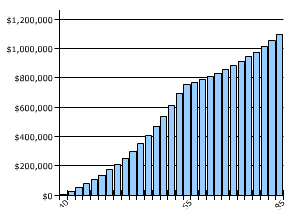What if we didn’t have to suffer the consequences of aging; what if things didn’t have to be this way? What if one day, each passing year meant an increase in your personal expected lifespan? What if we were even able to reverse the processes of aging, so that you could be restored to youthful vigor and vitality? Sounds like wishful thinking? Ever since the beginning of time, people have been searching for the Fountain of Youth. It hasn’t yet been discovered, but in the future, maybe a miraculous fountain won’t be needed.

New
Orleans Mardi Gras 1907. Illustration showing title float for Momus
parade. "The Quest for the Fountain of Youth". Source:
http://nutrias.org/~nopl/monthly/february2007/february2007.htm
Agricultural revolution: ~10 000 years
Bronze age: ~4 000 years
Iron age: ~3 000 years
Widespread use of gunpowder; widespread sailing across the oceans: ~500 years
Industrial revolution: ~200 years
Flight; automobiles: ~100 years
TV: ~70 years
Transatlantic flight: ~50 years
Lunar landing: ~40 years
Beginning of widespread Internet use (information revolution?): ~15 years
Arriving at the singularity
As you can see, the pace of technological advance has been accelerating. The amount of change in the last 100 years alone is simply incredible, compared to all of the centuries before. It’s hard to comprehend the vast amount of change for those of us who have only been around a couple of decades, but if you had been born 100 years ago, then there would be no TV, no Internet, no international flights, no nuclear power plants… we have changed the world tremendously in the past 100 years.As a species, we have greatly reduced the incidence of disease, we have greatly increased the dissemination of information; heck, in spite of all the bad news that you read about, the human race has built an amazing wealth of capital and technology. We stand on the shoulders of giants, of all those who have come before us and contributed to the accumulation of knowledge and progress. We’ve stumbled along the way, too, especially in the first half of this century with two world wars and with clashes of irreconcilable ideologies, but this doesn’t mean that we haven’t made a great deal of progress, in spite of the challenges that we have faced.
Given the improvements to our living conditions and to lifespans, why is it that we still imagine our later years as being more or less similar to how they’ve always been? Surely with all the change in the past 100 years, the change coming up is going to be even more incredible. It’s just hard to see, since we are actually living through these times and experiencing the progression of history first hand.
So, is this really what is still in store for us? Maybe not anymore. One guy who has put a great deal of thought into these ideas is Ray Kurzweil; you can read more about his thoughts on the singularity at his site, KurzweilAI.net.
The retirement plan
So, what does this mean for our retirement plan? First, let’s take a look at how retirement plans are often done today. The usual retirement plan takes a regular savings plan and places a few assumptions on it, such as a compound annual return of 8%, a retirement age of 65 or before, and a life expectancy of another 15-20 years beyond that. The savings built up over time are drawn down during retirement, and it looks something like this:There are a few issues with this sort of a plan:
- What happens if you live “too long”? You no longer have any retirement savings.
- What if your income changes over time? There is no longer a full-time work guarantee for many of us.
- Do you really want to settle for a “so-so” retirement, watching your nest egg dwindle with each passing day?
How can we get here? In order to achieve this, we can’t stick with a traditional plan, but we have to take the call to action and go above and beyond that. There are a few key points that will help form the foundation of this new retirement plan:
- Reducing expenses (Yakezie blog).
- Growing a money tree of savings.
- Building passive income (Yakezie blog).





No comments:
Post a Comment